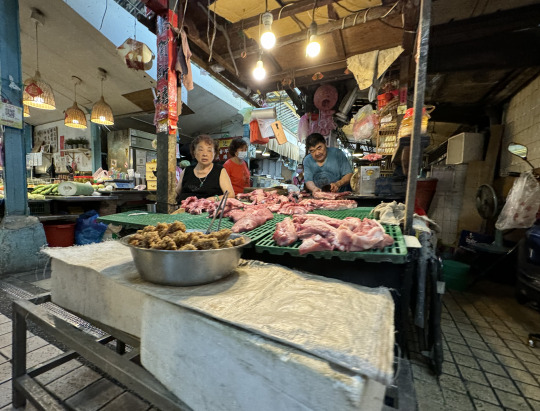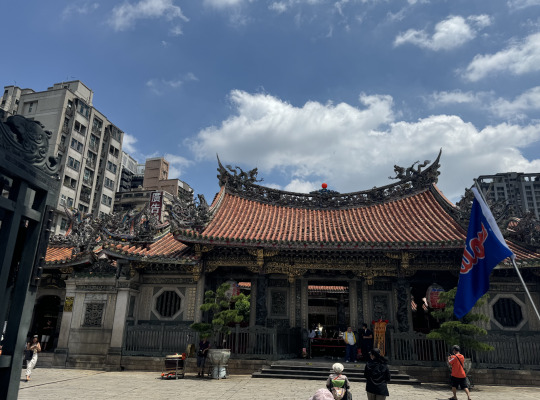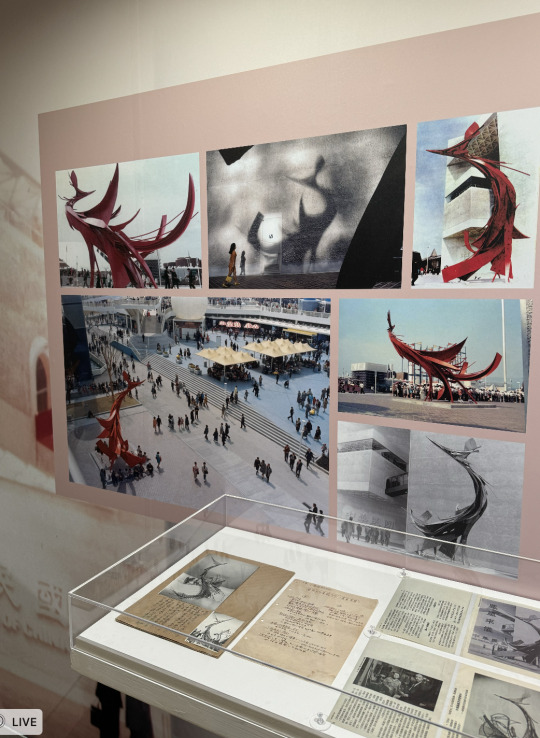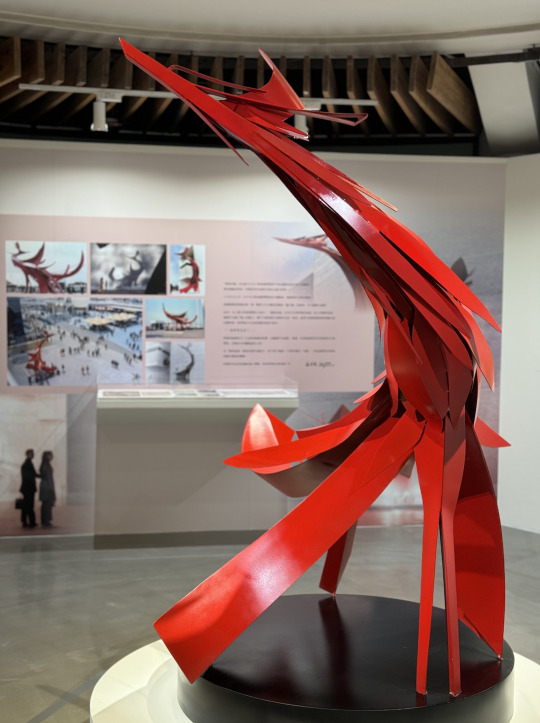#Taipei Botanical Garden
Explore tagged Tumblr posts
Text




#taipei#taiwan#cactus#succulents#greenhouse#plants#botanical garden#taipei botanical garden#台北植物園#green
37 notes
·
View notes
Text

Frog Payphone, Taipei Botanical Garden (Taiwan)
22 notes
·
View notes
Text
July 13 - Taipei - Long Shan Temple, hot pot, Yuyu Yang
Our morning was filled with multiple incredible stops that showed me lots of Taipei culture. The first was a wet market, an outdoor market, only open in the mornings, where you buy any fresh groceries you would need. Some of the lots had specialized in entire chickens or beef, assorted fruits, assorted vegetables, clothing, infant clothing, shoes, or other items. Our tour guide, Peter, explained how these markets were more prevalent when he was younger, as there are now regular supermarkets that locals can also visit. Next up was the Long Shan temple (Dragon Mountain temple), which was very cool. Besides the temple's beautiful and intricate design, I took part in throwing the two moon blocks. Depending on which side faces up, you can get a yes, no, or maybe answer for any question you ask. I asked if I would get a good job soon and flipped a yes!! For the last part of the guided tour, we walked through a beautiful botanical garden and toured the Yuyu Yang (an esteemed Taiwanese artist) museum. I enjoyed how Yuyu Yang was excellent at not just one style of art but many different forms (laser art, sculpting, painting, etc). After this, we had the afternoon free, so 11 of us went and got an all-you-can-eat hotpot. It was a fantastic assortment. We got a spicy hotpot broth with tons of different meats and vegetables. We even all had a bite of a chicken testicle, which is apparently a delicacy. It didn't have a distinct taste, but it wasn't exactly good either.
Academic Reflection
I learned many things from our tour guide, Peter, when touring Taipei today. First of all, the wet market was an incredible experience. Although supermarkets are now more popular, locals in Taiwan still often use these wet markets. One fact I found most interesting is when Peter was a kid, his grandma took him to the wet market, and they would pick a live chicken and slaughter it right in front of him. The advantage of this is that you know that the chicken you are buying is extremely fresh.
Furthermore, I learned how Buddhism and Daoism (two of the most popular religions in Taiwan) were combined and used together sometimes. Specifically, the temple we visited (Long Shan Temple) was drawn from both religions. The best experience I had there was using the moon blocks. Yeh Lao Shi explained to us that after you throw them if the flat sides are both up, it means "maybe"; if the round sides are both up, it means "no," and if one side is flat and the other is round then it means "yes." Moon blocks are used to confirm various matters, such as correct ritual protocol, the gods' spiritual presence, or whether they have consumed the offerings made to them, in addition to questioning everyday matters.
Finally, I was very interested in the Yuyu Yang Museum. Although I have never had a significant interest in art, I found the museum on Yuyu Yang particularly interesting. To summarize what I read in the museum, Yang achieved incredible success in a wide range of mediums, such as watercolor, oil, woodblock print, comics, illustration, design, stone, clay, stainless steel sculptures, laser art, and more. His career cannot be reduced to a single title like "painter," "printmaker," or "sculptor," as he was a unique example of an all-around artist in Taiwan's modern art history. Throughout the museum, tons of art show his success. I particularly enjoyed the "Advent of the Phoenix" piece.





5 notes
·
View notes
Text
July 13 - Longshan Temple






Today in Taipei, Peter took us to four places. First, we went to a local wet market. I saw many fruits that I didn’t recognize and meats that I’ve never tried such as shark. Then, we walked through the oldest part of Taipei to get to Longshan Temple, which is a beautiful, ornate temple which has components of Buddhism and Daoism. They have these moon blocks that you can ask questions and get an answer. I used them. After that, we walked through Taipei Botanical Garden. They had these gorgeous lotus flowers. Lastly, we explored a museum near the garden which exclusively had art by Taiwanese sculptor Yuyu Yang. We were sent on our own for lunch, so I went to a hotpot restaurant with part of our group. The hotpot was very good, and I got to try some foods like chicken testicle. Later on, I had dinner at a small restaurant in Liaoning Street Market with two guys from the group. After dinner, some of us went out clubbing near Taipei 101 at Wave, which is the 32nd best club in the world according to DJ Magazine.
Academic Reflection:
The only reason I knew that there was shark meat at the wet market is because Peter pointed it out to me. He also taught us that they are less commonly used today because of supermarkets. On the way to the temple, he showed us the oldest part of Taipei. He explained to us the history of the arrival of different building materials. For example, the Dutch brought bricks, and we saw the brick part of the old building. Peter also explained that the older buildings are actually better because they have a covered corridor like a sidewalk so people can walk in the sunny heat and the rain.
At the temple, Yeh Laoshi and Peter explained to us how the moon blocks and other things worked. This information enhanced my experience because it became interactive once I was using the moon blocks myself. They also explained to us that the dragon statues on the temple show how it is not strictly Buddhist because only Daoists would put the dragons. The last piece of information they gave us at the temple was about each of the gods in the temple and what they were the god of. At the garden, Yeh Laoshi taught me that the showerhead part of the lotus flower has all the seeds.
3 notes
·
View notes
Text
July 13th, 2024 星期六 - 西門地 + 東三水街市場_新富市場 + Taipei Botanical Gardens
We met around 9:30 am and headed on the green line to the blue transfer station where we rode the MRT to the Longshan stop. As soon as we got out of the station, the Longshan Daoist/Buddhist temple was in view. It was very beautiful and colorful. First, we headed to the wet market. By the name, I assumed “wet market” meant mainly fish/seafood but it was just an outdoor market selling fruits, vegetables, meat, fish, and other goods. Our tour guide said that when he was a kid, he would go with his grandmother. It heavily reminded me of how I would go to very similar markets with my grandmother in Jamaica. As we entered through the dragon side, the wide variety of fresh produce could be seen everywhere you look. I noted that it was mostly older people buying and selling at the market. Our tour guide noted that there are increasingly less and less wet markets in Taiwan, as many opt to go to grocery stores instead.
After making our way through the market, we headed towards Longshan temple. A place of worship mixed with the Daoist and Buddhist beliefs, it was extremely colorful and adorned with porcelain, gold, and jade. As we walked through the temple, we got to see and try out using the moon stones to answer our questions. In the Daoist part of the temple, there were several shrines for different gods such as the gods of love, war, and health/wellness. There was also an area where one can buy talismans/good luck charms. I definitely want to return tomorrow to buy good luck charms for my friends and family.
After the temple, we rode the MRT again and ended up at the Taipei Botanical Gardens which we walked through before ending up at a museum for a famous Taiwanese Architect. After exploring the museum, we took the MRT once more and ended back in Ximendi, where class was dismissed. Afterwards, I went along with some of my classmates to eat hot pot. After lunch, the girls all went shopping around Ximendi for some cut clothes. We also colored the Red House and surrounding flea market shops before returning home on the MRT green line. Before entering the hotel, we stopped at a Family Mart so I could buy a special Kyoho grape redbull—something we definitely don’t have back home.
Academic Reflection
I was very interested in the wet markets we visited today. I ended up doing some research on wet markets in Taiwan, especially the differences between those in Taiwan and those in Mainland China. I found that apparently that has been a large increase in regulation of the wet markets in recent years. Live-killing of animals and the selling of live animals have been cracked down on, but you can still buy snakes, turtles, and live fish sometimes. I also found online how the Jianguo Wet Market in Taichung was torn down and re-made into a building that even includes industrial refrigerators and breastfeeding rooms.
Our tour guide also told us about a jade market that happens on the weekends a wet market like the one we visited today. Turns out it is the a similar area to the Jianguo market previously mentioned. This immediately sparked my interest because one of the things I really wanted to buy in Taiwan is jade jewelry. At this market, one can also buy an array of gorgeous flowers and plants. Located in Da’an and open from 9am to 6pm, there are about 700 stalls selling many goods from and flowers, to ceramics and furniture. I most definitely plan on going tomorrow to buy jade jewelry.










2 notes
·
View notes
Photo

by didy.didy on Flickr.Lotus pond in Taipei Botanical Garden, Taiwan.
2 notes
·
View notes
Photo

by didy.didy on Flickr.Lotus pond in Taipei Botanical Garden, Taiwan.
4 notes
·
View notes
Text
A white-rumped shama learning about the plants at the Taipei Botanical Gardens.

2 notes
·
View notes
Text



50 notes
·
View notes
Text
July 13 - Longshan Temple, Taipei Botanical Gardens, and more





Today was a much busier day than yesterday, we had a lot to see so we had to get started earlier. The first place we went to visit was Dongshanshui market which we quickly just passed through to see all the different kinds of shops it had to offer. It was almost saddening to hear tour guide Peter say that people tend to shop at these markets less with supermarkets becoming more preferred. However, I was glad to see that there was still a significant amount of traffic going on inside the market. The next place we walked through was Bopiliao Historical Block, which I found particularly interesting. Our last place to see in this area was Longshan Temple, which was incredibly beautiful. It’s always such a pleasure to see temples such as Longshan, as there is nothing quite like them in the United States. After the temple we got back on the metro and took it to the Taipei Botanical Gardens, which was a nice escape from the bustling city that surrounds it. Right next to the gardens was the National Taiwan Craft Research and Development Institute, which housed the amazing art and sculptures of Yuyu Yang.
For me the most interesting part of the day was the Bopiliao Historical Block. As a history major it's always really interesting to see how fusions of different cultures blend together to create entirely new ones, and this block was a physical manifestation of that. The block was heavily influenced by the Qing Dynasty and Japanese historical periods. What I found particularly interesting though was the significant use of brick. Tour guide Peter mentioned bricks were introduced by Europeans, and as I walked through the street in this area I couldn’t help but feel that European influence. Despite the buildings being made of different materials, I felt similar to how I do when I walk the streets of St. Augustine, another historic town that was heavily influenced by European architecture. Had tour guide Peter not told me the history of the usage of bricks in the historical block, I would have never guessed that it actually had some European influence. One lesson I remember very clearly from a history practicum class I had to take was how different things could be used as primary sources. One example that my teacher gave that stuck with me was how architecture could tell a story of an area. I think the Bopiliao Historical Block is proof of that lesson. The design of this amazing area shows how decades of different influences shaped Taiwan into what it is today.
1 note
·
View note
Photo

by didy.didy on Flickr.Lotus pond in Taipei Botanical Garden, Taiwan.
0 notes
Text
by didy.didy on Flickr.Lotus pond in Taipei Botanical Garden, Taiwan.

0 notes
Photo

by didy.didy on Flickr.Lotus pond in Taipei Botanical Garden, Taiwan.
1 note
·
View note
Text
by didy.didy on Flickr.Lotus pond in Taipei Botanical Garden, Taiwan.

0 notes
Text

Day 6
📍Taipei Botanical Garden
1.03.2019 | 📸 @kristinemaeb
#2019#2019Jan#krizwanders#kristinemaebsnapshots#krizwandersintaiwan#taipei#whenintaiwan#taipeibotanicalgarden#travelgram#garden#naturelovers
0 notes
